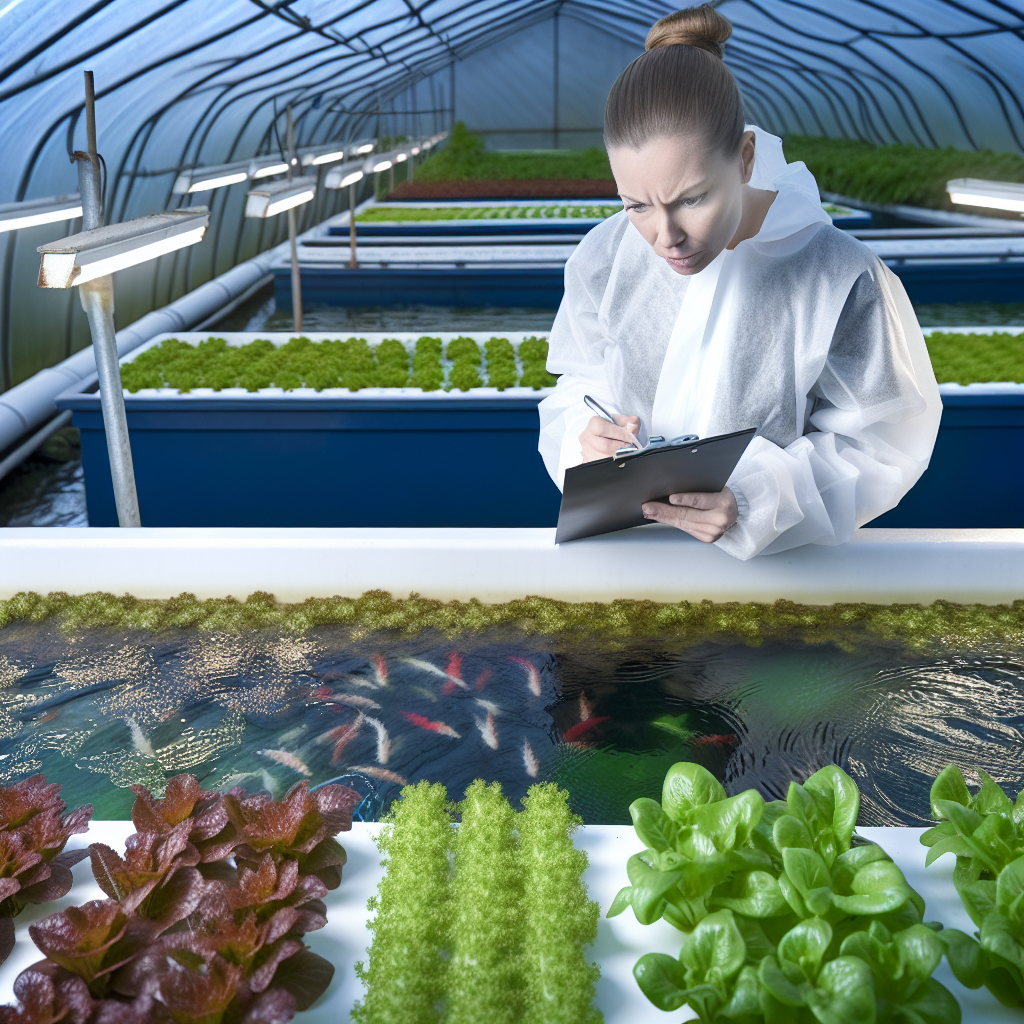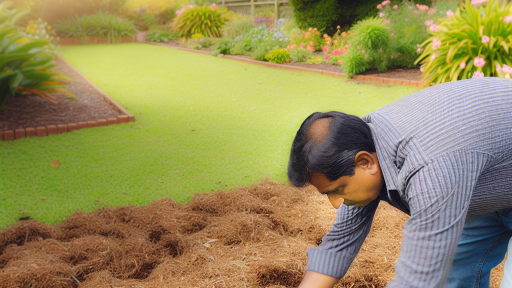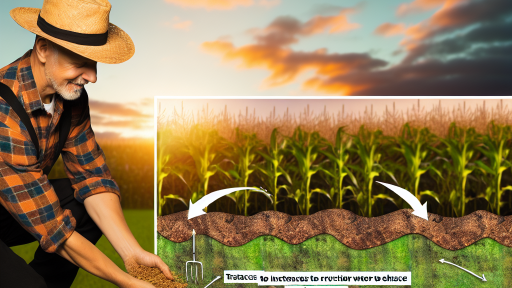Introduction to Integrated Pest Management in Aquaponics
Understanding Integrated Pest Management
Integrated Pest Management (IPM) is a comprehensive approach to pest control.
It emphasizes the use of environmentally friendly practices.
IPM incorporates biological, cultural, chemical, and physical methods.
This method reduces reliance on harmful pesticides.
Consequently, IPM helps sustain the health of aquatic and plant life.
The Importance of IPM in Aquaponics
IPM plays a crucial role in aquaponics systems.
These systems integrate fish farming and plant cultivation.
Proper pest management ensures fish health while supporting plant growth.
This balance is vital for overall system productivity.
Common Pests in Aquaponics
Several pests may threaten aquaponics environments.
Some common ones include aphids, mealybugs, and spider mites.
Furthermore, fungal infections can arise, affecting plant health.
Identifying these pests early is essential for effective management.
Components of an Effective IPM Strategy
An effective IPM strategy involves multiple components.
First, monitoring pest populations is vital.
Transform Your Agribusiness
Unlock your farm's potential with expert advice tailored to your needs. Get actionable steps that drive real results.
Get StartedThis helps in determining when intervention is necessary.
Second, implementing cultural practices can deter pests naturally.
Examples include rotating crops and managing water quality.
Additionally, introducing beneficial organisms can provide natural pest control.
For instance, ladybugs can effectively manage aphid populations.
Finally, chemical interventions should be a last resort.
When necessary, opt for organic solutions that minimize harm.
Monitoring and Assessment
Regular monitoring is essential in IPM practices.
Assessing plant and fish health helps in early pest detection.
Employing traps can effectively gauge pest populations.
Recording the data allows for informed decision-making.
Long-term Benefits of IPM
Implementing IPM leads to long-term sustainability in aquaponics.
It enhances the resilience of both plants and fish against pests.
Moreover, it promotes biodiversity in the ecosystem.
Consequently, growers can achieve better yields over time.
Key Principles of IPM and Their Relevance to Aquaponics Systems
Understanding Integrated Pest Management
Integrated Pest Management (IPM) combines multiple strategies to manage pests effectively.
This approach reduces reliance on chemical pesticides.
Consequently, it promotes sustainable agricultural practices.
In aquaponics systems, IPM plays a crucial role in maintaining balance.
Monitoring and Identifying Pests
Effective pest management begins with regular monitoring.
Farmers should routinely inspect plants and aquatic life.
Identifying pests early can prevent infestations from escalating.
Using traps or visual inspections can provide valuable insights.
Utilizing Biological Control Methods
Biological control involves using natural predators to manage pests.
Showcase Your Farming Business
Publish your professional farming services profile on our blog for a one-time fee of $200 and reach a dedicated audience of farmers and agribusiness owners.
Publish Your ProfileFor instance, introducing ladybugs can help control aphid populations.
This method promotes biodiversity within the system.
Moreover, it minimizes harm to beneficial organisms.
Implementing Cultural Practices
Cultural practices aid in reducing pest populations.
Rotating crops and diversifying plant species can disrupt pest life cycles.
Additionally, maintaining optimal water quality supports plant health.
Healthy plants are less susceptible to pest attacks.
Employing Mechanical and Physical Controls
Mechanical methods involve using physical barriers to protect crops.
Netting or row covers can deter insect pests effectively.
Maintaining cleanliness in the aquaponics system also prevents infestations.
Regularly removing debris reduces hiding spots for pests.
Applying Chemical Controls Sparingly
If other methods fail, chemical controls might be necessary.
However, aquaponics systems require careful consideration.
Choose organic or less harmful pesticides when possible.
Read labels to avoid detrimental effects on fish and plants.
Evaluating and Adjusting IPM Strategies
Continuous evaluation of IPM strategies is essential.
Farmers should assess the effectiveness of their approaches regularly.
Adjusting strategies based on observed pest populations can optimize outcomes.
This adaptive management ensures long-term success.
Education and Community Engagement
Educating oneself and others about IPM is vital.
Participating in workshops can enhance knowledge of effective practices.
Engaging with the community fosters collaboration in pest management.
Sharing successes and challenges can lead to innovative solutions.
Common Pests in Aquaponics: Identification and Impact
Overview of Pests in Aquaponics
Pests can threaten aquaponic systems significantly.
They can damage plants and affect fish health.
Identifying these pests quickly is essential for effective management.
Common Pests in Aquaponics Systems
Several pests are frequently seen in aquaponics systems.
These pests include aphids, whiteflies, and spider mites.
Each of them has distinct characteristics and impacts.
Aphids and Their Impact
Aphids are small, soft-bodied insects.
They feed on plant sap, weakening the plants.
This feeding can reduce plant vigor significantly.
Additionally, aphids can transmit viruses among plants.
Whiteflies and Their Consequences
Whiteflies are tiny, flying insects that damage crops.
They also suck sap from the leaves.
These pests can lead to leaf yellowing and wilting.
Furthermore, whiteflies can produce sticky honeydew, resulting in sooty mold.
Spider Mites: A Silent Threat
Spider mites are tiny relatives of spiders.
They can cause serious damage to aquaponic plants.
They typically live on the undersides of leaves.
Showcase Your Farming Business
Publish your professional farming services profile on our blog for a one-time fee of $200 and reach a dedicated audience of farmers and agribusiness owners.
Publish Your ProfileInfestations can lead to leaf stippling and premature drop.
Impact on Aquaponics Ecosystem
Pest infestations can disrupt the ecological balance of systems.
This disruption can reduce both plant and fish health.
Moreover, pest management often involves chemicals that can harm aquatic life.
Therefore, integrated pest management (IPM) is critical.
Why Integrated Pest Management Matters
IPM combines different strategies to control pests naturally.
It minimizes the use of harmful pesticides.
This approach supports a healthy ecosystem in aquaponic systems.
By using IPM, growers can protect both plants and fish effectively.
See Related Content: Soil Microbiology: Enhancing Fertility Naturally
Cultural Control Practices for Pest Management in Aquaponics
Understanding Cultural Controls
Cultural controls emphasize practices that enhance plant health.
These methods reduce the risks of pest infestations.
Proper cultural controls can make significant differences in aquaponics systems.
Crop Rotation
Implementing crop rotation prevents pest buildup in the system.
This practice involves changing the crops grown in each aquaponics cycle.
Additionally, it disrupts the life cycles of pest populations.
Choosing Resilient Plant Varieties
Selecting resilient plant varieties increases pest resistance.
Always research and choose plants that are less prone to infestation.
By doing this, you can significantly decrease pest pressure.
Manipulating Plant Spacing
Proper plant spacing enhances air circulation.
Good air circulation deters pests and limits humidity.
Increasing space between plants also promotes healthy growth.
Implementing Companion Planting
Companion planting involves growing different plants together.
This strategy can deter pests naturally through scent or chemical release.
For example, planting basil alongside tomatoes can repel certain pests.
Maintaining Cleanliness in the System
A clean aquaponics environment prevents pest infestations.
Regularly remove dead plant material and debris.
Keep the system tidy to discourage pests from taking up residence.
Monitoring Environmental Conditions
Keeping an eye on environmental factors helps control pests.
Monitor temperature, humidity, and light to ensure optimal growth.
Strong, healthy plants are more resilient against pest attacks.
Using Organic Fertilizers
Employing organic fertilizers boosts plant health naturally.
Healthy plants are better at repelling pests and diseases.
Therefore, prioritize the use of organic options in your system.
Regular Observation and Monitoring
Regularly inspect plants for early signs of pest activity.
Quick identification allows for timely intervention.
Taking prompt action minimizes damage and pest spread.
See Related Content: Optimizing Light for Hydroponic Growth
Biological Control Methods
Understanding Biological Control
Biological control utilizes natural enemies to manage pests.
This method limits the need for chemical pesticides.
Showcase Your Farming Business
Publish your professional farming services profile on our blog for a one-time fee of $200 and reach a dedicated audience of farmers and agribusiness owners.
Publish Your ProfileIntegrating beneficial organisms promotes a balanced ecosystem.
Types of Beneficial Organisms
Several types of beneficial organisms help in pest management.
- Predators attack and consume pests directly.
- Parasitoids lay eggs inside or on pests, leading to their demise.
- Pathogens, such as bacteria and fungi, infect and kill harmful insects.
Application in Aquaponics Systems
In aquaponics, beneficial organisms work symbiotically with plants and fish.
For instance, ladybugs control aphid populations effectively.
Nematodes can target harmful soil insects, promoting healthier plants.
Creating a Habitat for Beneficial Organisms
Successful implementation requires creating suitable habitats.
Implementing diverse plant species attracts and sustains beneficial insects.
Additionally, providing adequate shelter aids in their survival.
Monitoring and Evaluating Effectiveness
Regular monitoring assesses the effectiveness of biological control methods.
Documentation helps track pest populations and beneficial organisms.
Adjustments can be made based on observed results over time.
Challenges and Considerations
While effective, biological control has its challenges.
Not all beneficial organisms are equally effective against every pest.
Additionally, some methods require specific environmental conditions.
Balancing the ecosystem remains a priority to ensure success.
Gain More Insights: Scaling Up Your Aquaponics Business
Chemical Control: Safe and Effective Pesticide Use in Aquaponics
Importance of Integrated Pest Management
Aquaponics systems require careful pest management.
Healthy crops and fish sustain each other in this ecosystem.
Integrated Pest Management (IPM) combines various techniques effectively.
This approach minimizes harm to both fish and plants.
Choosing Safe Pesticides
Select pesticides that are safe for aquaponics environments.
Look for those labeled as organic or specifically formulated for aquaculture.
Research the ingredients carefully.
Avoid substances harmful to aquatic life.
Application Techniques
Apply pesticides during low light or calm periods.
This prevents pesticide drift and exposure to fish.
Use targeted spray methods to reduce waste.
Consider using gloves and a mask for personal protection.
Monitoring and Evaluation
Constantly monitor pest populations in your system.
Regularly check for plant health and fish behavior.
Adjust pesticide use based on effectiveness and pest resistance.
Ensure you maintain records of pesticide applications.
Alternatives to Chemical Control
Incorporate beneficial insects into your aquaponics setup.
Use beneficial nematodes for pest control in soil.
Implement physical barriers to protect crops.
Consider companion planting to deter pests naturally.
Learn More: Innovative Approaches To Pest Forecasting For Farmers

Monitoring and Assessing Pest Populations
Importance of Monitoring
Monitoring pest populations helps identify potential problems early.
Timely action can prevent minor infestations from becoming severe issues.
Regular monitoring supports informed decisions regarding pest management.
Showcase Your Farming Business
Publish your professional farming services profile on our blog for a one-time fee of $200 and reach a dedicated audience of farmers and agribusiness owners.
Publish Your ProfileTools for Monitoring
Various tools assist in monitoring pest populations effectively.
- Sticky traps capture flying insects.
- Soil sampling detects soil-dwelling pests.
- Pheromone traps attract specific pests for assessment.
These tools provide valuable data about pest presence and density.
Techniques for Assessment
Employ diverse techniques for assessing pest populations.
Visual inspections offer immediate insights into pest numbers.
Regularly check plants and aquatic environments for signs of damage.
Additionally, use sweep netting to collect pests from plants.
Data Collection and Analysis
Collect data systematically for effective analysis.
Document findings in a pest diary for future reference.
Analyze trends to understand pest behavior and population dynamics.
Engaging Community Input
Involve local growers in pest monitoring efforts.
Share information and experiences to enhance collective knowledge.
Collaboration can lead to more effective pest management strategies.
Case Studies: Successful IPM Implementations in Aquaponics
Introduction to IPM in Aquaponics
Integrated Pest Management plays a crucial role in aquaponics.
It combines biological control with sustainable farming practices.
This method protects both fish and plants from harmful pests.
Case Study: Green Haven Aquaponics
Green Haven Aquaponics successfully integrated IPM into their system.
They employed a diverse range of beneficial insects.
Ladybugs and lacewings helped control aphids effectively.
Additionally, they monitored pest populations regularly.
This proactive approach minimized chemical interventions.
Case Study: EcoSustain Farm
EcoSustain Farm focused on preventive measures in their IPM strategy.
They introduced companion planting to deter pests.
For example, marigolds were planted alongside lettuce.
This combination effectively reduced nematode populations.
Moreover, they used physical barriers like row covers.
Case Study: Aquaponics Innovations
Aquaponics Innovations implemented a data-driven IPM approach.
They utilized sensors to track pest activity in real-time.
This technology allowed for timely interventions.
They also educated their staff about pest identification.
Regular training ensured adherence to IPM practices.
Key Takeaways from the Case Studies
- Diverse beneficial insects can significantly control pests.
- Preventive measures are crucial for effective pest management.
- Technological advancements enhance pest monitoring and control.
- Staff education promotes successful IPM implementation.
Challenges and Limitations of IPM in Aquaponics Systems
Aquaponics systems involve complex relationships between fish and plants.
These interactions can complicate pest management strategies.
For instance, certain pests may affect both fish and plants.
Identifying the best control methods can be challenging.
Complex Interactions
Access to effective pest control resources may be restricted.
Many traditional pesticides are unsuitable for aquaponics.
This limitation leads to reliance on fewer control options.
Consequently, managing pest outbreaks can become difficult.
Limited Resource Availability
Aquaponics systems are sensitive to environmental changes.
Changes in water quality can affect both fish and plants negatively.
Showcase Your Farming Business
Publish your professional farming services profile on our blog for a one-time fee of $200 and reach a dedicated audience of farmers and agribusiness owners.
Publish Your ProfileMoreover, many pest control measures may disrupt this balance.
Thus, maintaining a healthy ecosystem requires careful monitoring.
Environmental Sensitivity
There is a lack of research specifically for pest management in aquaponics.
Most guidelines focus on either aquaculture or hydroponics alone.
This gap leaves aquaponics practitioners without proven strategies.
As a result, they may struggle to implement effective IPM practices.
Lack of Research and Guidelines
Financial limitations can hinder the implementation of IPM practices.
Many aquaponics farms operate on tight budgets.
They may prioritize production over pest management strategies.
This can lead to compromised plant and fish health.
Economic Constraints
Many aquaponics practitioners lack experience in pest management.
Limited knowledge about IPM can lead to ineffective practices.
Training and resources are essential to improve management skills.
Without proper guidance, practitioners may face recurring pest issues.
Experience and Knowledge Gaps
Future Trends in Integrated Pest Management for Sustainable Aquaponics
Emphasis on Biocontrol Solutions
Biocontrol solutions are becoming increasingly popular in aquaponics.
These methods use natural predators to manage pest populations effectively.
For instance, introducing ladybugs can significantly reduce aphid infestations.
As a result, growers observe healthier plants and overall system balance.
Advancements in Technology
Technology is transforming pest management in aquaponics.
Precision agriculture tools allow for real-time monitoring of pest populations.
For example, drones can survey and identify affected areas quickly.
This immediate feedback enables timely interventions, minimizing pest damage.
Integration of Eco-Friendly Practices
Aquaponics is leaning towards eco-friendly pest management practices.
Natural pesticides, such as neem oil, are gaining traction among aquaponic farmers.
These substances offer effective control without harming beneficial organisms.
Farmers are increasingly aware of their environmental impact while selecting pest control options.
Collaboration Between Growers and Researchers
Collaborative efforts are vital for evolving pest management strategies.
Farmers are partnering with researchers to share best practices and innovations.
This collaboration fosters knowledge exchange about pest-resistant plant varieties.
Furthermore, it helps in understanding pest behavior in aquaponic environments.
Education and Training Opportunities
There is a growing need for education in integrated pest management techniques.
Workshops and online courses can enhance farmers’ knowledge and skills.
By participating, growers become more adept at identifying and managing pest issues.
Moreover, they learn to utilize sustainable methods efficiently.
Development of Comprehensive Management Plans
Future trends emphasize the importance of comprehensive pest management plans.
These plans assess local pest threats and tailor strategies accordingly.
They incorporate cultural, mechanical, and biological control methods.
Ultimately, this approach helps maintain the aquaponic ecosystem’s integrity.
Additional Resources
All About Integrated Pest Management | Research, Innovation, and …
Sustainable Pest Management – SARE
Showcase Your Farming Business
Publish your professional farming services profile on our blog for a one-time fee of $200 and reach a dedicated audience of farmers and agribusiness owners.
Publish Your Profile



